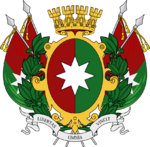Miskism
| Part of a series on |
| Miskism |
|---|
| Religion in Esquarium |
| Beliefs |
| Tradition and practice |
| See also |
Miskism (Aucurian: miškybė) is the traditional ethnic religion of the Aucurian people. Polytheistic and animistic, Miskism focuses upon a diverse cast of gods and spirits, the ties between the physical and spiritual worlds, and upon human moral obligations to uphold the harmony of reality, known as darna, in their pursuit of the asmatikslai. It is sometimes called the "Aucurian national religion", though it holds no official status.
References to certain Miskist rituals and figures appear in Neo-Sepcan and Tastanist texts as far back as the 5th century CE; however, the recording of Miskist myths by practicioners of the religion cannot be traced back farther than the 8th century, and the codification of Miskist practices and rituals seems to begin in the 11th century, alongside the rise of the Kingdom of Aucuria. Miskist theology, philosophy, and mysticism flowered during the High Middle Ages. Efforts at conversion by Tastanism and Cositene polities and missionaries proved largely unsuccessful, though Tastano-Cositene notions such as zakon did influence Miskist thought.
Following a period of comparative stagnation, mirrored by the Torpor in continental West Borea, Miskism experienced a revival beginning in the 16th and 17th centuries, being influenced by syncarist ideals such as humanism and rationalism. Though the Aucurian Revolution resulted in the secularization of Aucurian governance, guarantees of freedom of religion in the Declaration of the Rights of the People and Constitution of Aucuria allowed the religion to continue to operate broadly and openly in the public sphere. The religion has continued to thrive into the present.
Miskism has traditionally been a major part of Aucurian culture, playing an important role in Aucurian literature, poetry, music, and philosophy, and remains the largest religion in Aucuria today. The religion also has strong monastic and mystical traditions. It has historically been influenced by Tastanism, Costeny, Saturnism, and Kelemism.
While philosophical schools known as paražai and associations of Miskist shrines and temples exist, Miskism lacks a centralized religious authority, and different individuals and groups place emphasis upon different theological concepts, scriptures, and holy figures. It is estimated that roughly nine million people are Miskists.
Etymology
Miskism is known by a variety of vernacular names within Aucuria, including senovės takas ("the ancient path"), amžinas takas ("the eternal path"), dievu takas ("the path of the gods"), darnos takas ("the path of darna"), girios takas ("the path of the wilderness"), and miško takas ("the path of the forest"). It is from the lattermost of these that the Aucurian miškybė, and thence the French miskisme, are derived.
Though the religion is now referred to officially as miškybė within Aucuria, the term itself appears to have been a comparatively late development, and is not attested before the 16th century. Some linguists have proposed that it was created in imitation of the names of foreign religions such as Tastanism, Costeny, and Saturnism (tastanybė, kostenybė, and saturnybė in Aucurian).
Beliefs
Darna
Asmatikslai
Deities
Spirits
Saints
Tikrovas
Afterlife
Scriptures

Main traditions
Paražai
Miskism has seven paražai (sing. paražas; "tradition"), of which five are considered "orthodox traditions" (stačiatikiu paražai) and two are considered "heterodox traditions" (nestačiatikiu paražai).
Orthodox paražai
Heterodox paražai
Folk Miskism
Practices
Ethics
Worship
Public worship

Private worship

Religious sites

Clergy
Holidays
Seasonal celebrations
Other holidays
Life-cycle events
tbd coming of age ritual
Marriage
Death and mourning
History
Before 1025





